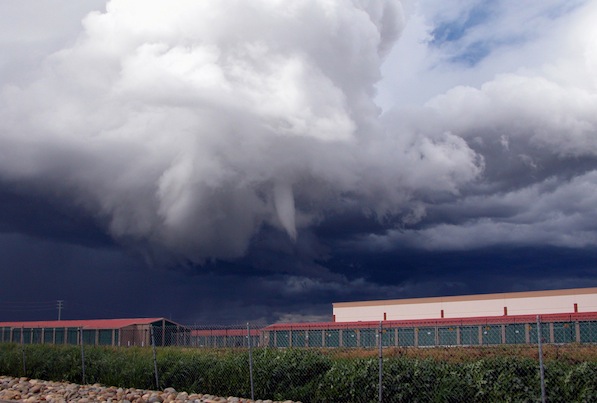Scientists warn California could be struck by winter "superstorm"
科学家们警告金色加州自2010可能会遭遇冬雨季的“超级暴雨”
呵呵,主第二来临的日子越来越近了。信不信由你!
据U.S. Geological Survey(USGS), 美国联邦地质调查局报告(1/17/2011),
超过100名的科学家和专家在一份新报告中断言加利福里亚州正面临一个200年一 遇的巨大“超级暴雨”的风险。届时加州的四分之一房子和土地会被淹没,水深近十英尺,时间长达四十天。损失达3000至4000亿美元。专家们指出潜在的 破坏程度相当与一场大型地震(7.8)引起破坏烈度的4-5倍。

详细报道请见下面链接和里面的相关报告。
http://news.yahoo.com/s/yblog_thelookout/20110117/us_yblog_thelookout/scientists-
warn-california-could-be-struck-by-winter-superstorm
A group of more than 100 scientists and experts say in a new report that
California faces the risk of a massive "superstorm" that could flood a quarter
of the state's homes and cause $300 billion to $400 billion in damage. Researchers
point out that the potential scale of destruction in this storm scenario
is four or five times the amount of damage that could be wrought by a major
earthquake.
http://pubs.usgs.gov/of/2010/1312/
Overview of the ARkStorm ScenarioBy Keith Porter, Anne Wein, Charles Alpers, Allan Baez, Patrick Barnard,
James Carter, Alessandra Corsi, James Costner, Dale Cox, Tapash Das, Michael
Dettinger, James Done, Charles Eadie, Marcia Eymann, Justin Ferris, Prasad
Gunturi, Mimi Hughes, Robert Jarrett, Laurie Johnson, Hanh Dam Le-Griffin,
David Mitchell, Suzette Morman, Paul Neiman, Anna Olsen, Suzanne Perry,
Geoffrey Plumlee, Martin Ralph, David Reynolds, Adam Rose, Kathleen Schaefer,
Julie Serakos, William Siembieda, Jonathon Stock, David Strong, Ian Sue
Wing, Alex Tang, Pete Thomas, Ken Topping, and Chris Wills; Lucile Jones,
Chief Scientist, Dale Cox, Project Manager
ABSTRACTThumbnail of and link to report PDF (41.6 MB)
The U.S. Geological Survey, Multi Hazards Demonstration Project (MHDP) uses
hazards science to improve resiliency of communities to natural disasters
including earthquakes, tsunamis, wildfires, landslides, floods and coastal
erosion. The project engages emergency planners, businesses, universities,
government agencies, and others in preparing for major natural disasters.
The project also helps to set research goals and provides decision-making
information for loss reduction and improved resiliency. The first public
product of the MHDP was the ShakeOut Earthquake Scenario published in May
2008. This detailed depiction of a hypothetical magnitude 7.8 earthquake
on the San Andreas Fault in southern California served as the centerpiece
of the largest earthquake drill in United States history, involving over
5,000 emergency responders and the participation of over 5.5 million citizens.
This document summarizes the next major public project for MHDP, a winter
storm scenario called ARkStorm (for Atmospheric River 1,000). Experts have
designed a large, scientifically realistic meteorological event followed
by an examination of the secondary hazards (for example, landslides and
flooding), physical damages to the built environment, and social and economic
consequences. The hypothetical storm depicted here would strike the U.S.
West Coast and be similar to the intense California winter storms of 1861
and 1862 that left the central valley of California impassible. The storm
is estimated to produce precipitation that in many places exceeds levels
only experienced on average once every 500 to 1,000 years.
Extensive flooding results. In many cases flooding overwhelms the state’s
flood-protection system, which is typically designed to resist 100- to 200-year
runoffs. The Central Valley experiences hypothetical flooding 300 miles
long and 20 or more miles wide. Serious flooding also occurs in Orange County,
Los Angeles County, San Diego, the San Francisco Bay area, and other coastal
communities. Windspeeds in some places reach 125 miles per hour, hurricane-force
winds. Across wider areas of the state, winds reach 60 miles per hour. Hundreds
of landslides damage roads, highways, and homes. Property damage exceeds
$300 billion, most from flooding. Demand surge (an increase in labor rates
and other repair costs after major natural disasters) could increase property
losses by 20 percent. Agricultural losses and other costs to repair lifelines,
dewater (drain) flooded islands, and repair damage from landslides, brings
the total direct property loss to nearly $400 billion, of which $20 to $30
billion would be recoverable through public and commercial insurance. Power,
water, sewer, and other lifelines experience damage that takes weeks or
months to restore. Flooding evacuation could involve 1.5 million residents
in the inland region and delta counties. Business interruption costs reach
$325 billion in addition to the $400 property repair costs, meaning that
an ARkStorm could cost on the order of $725 billion, which is nearly 3 times
the loss deemed to be realistic by the ShakeOut authors for a severe southern
California earthquake, an event with roughly the same annual occurrence
probability.
The ARkStorm has several public policy implications: (1) An ARkStorm raises
serious questions about the ability of existing federal, state, and local
disaster planning to handle a disaster of this magnitude. (2) A core policy
issue raised is whether to pay now to mitigate, or pay a lot more later
for recovery. (3) Innovative financing solutions are likely to be needed
to avoid fiscal crisis and adequately fund response and recovery costs from
a similar, real, disaster. (4) Responders and government managers at all
levels could be encouraged to conduct risk assessments, and devise the full
spectrum of exercises, to exercise ability of their plans to address a similar
event. (5) ARkStorm can be a reference point for application of Federal
Emergency Management Agency (FEMA) and California Emergency Management Agency
guidance connecting federal, state and local natural hazards mapping and
mitigation planning under the National Flood Insurance Plan and Disaster
Mitigation Act of 2000. (6) Common messages to educate the public about the
risk of such an extreme disaster as the ARkStorm scenario could be developed
and consistently communicated to facilitate policy formulation and transformation.
These impacts were estimated by a team of 117 scientists, engineers, public-policy
experts, insurance experts, and employees of the affected lifelines. In
many aspects the ARkStorm produced new science, such as the model of coastal
inundation. The products of the ARkStorm are intended for use by emergency
planners, utility operators, policymakers, and others to inform preparedness
plans and to enhance resiliency.
